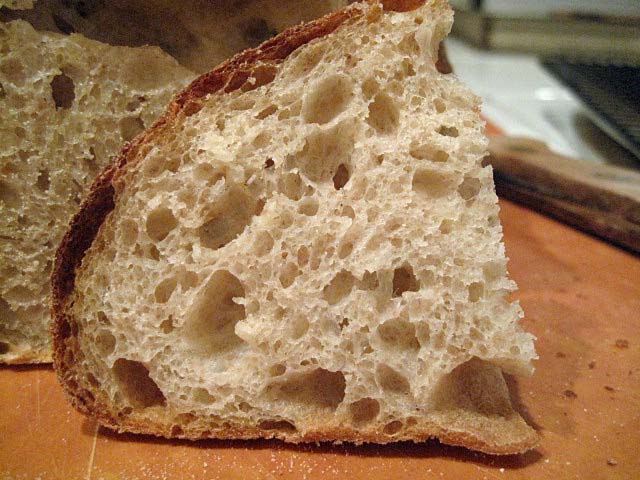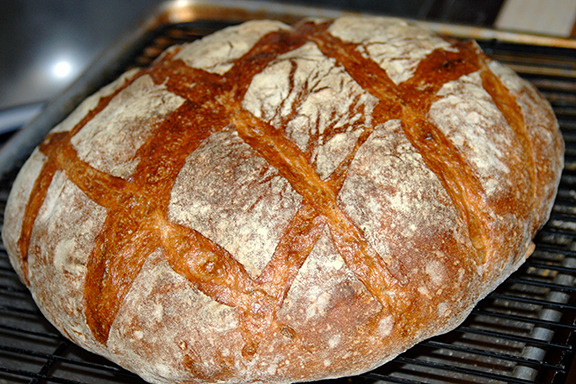
Oven steaming using the SFBI method.
When I took the Artisan I workshop at the San Francisco Baking Institute last August, Miyuki demonstrated the method of oven steaming they recommend for home bakers.
The oven is not pre-steamed (before loading the loaves). A cast iron skillet filled with steel pieces (nuts and bolts, rebar pieces) is pre-heated in the oven along with two baking stones. One stone is placed on a rack above the stone and rack on which the loaves will be loaded.
When the loaves are loaded, a perforated pie tin filled with ice cubes is set atop the skillet. As the ice melts, water drips through the perforations and turns to steam when it hits the metal pieces.

I had a hard time finding the perforated pie tins, so I hadn't been able to try this method until today. I did two bakes: One was two loaves of a very familiar bread – Hamelman's “Vermont Sourdough with Increased Whole Grain” from “Bread.” The other was a new bread to me - Chad Robertson's “Basic Country Bread” from “Tartine.” I made two large boules of the Country Bread. One was baked using the “Magic Bowl” technique and the other with the SFBI steaming method, minus the second baking stone and using lava rocks in place of metal pieces.
My current baking method is to pre-heat the oven to 500ºF with the baking stone and skillet in place. When I load my loaves, I turn down the oven to whatever temperature the recipe specifies, using the conventional bake setting. After 10-15 minutes (depending on the total length of the bake), I change the oven setting to convection bake but 25ºF lower. I find, in my oven, conventional baking retains steam well, but convection dries the crust better.
Using the SFBI steaming method, the Vermont Sourdoughs came out substantially similar to how they come out with my previous method – pouring boiling water over the lava rocks. I could not detect any difference in oven spring, bloom, crust color or the texture of either the crust or crumb.

Vermont Sourdough with Increased Whole Grain

Crust Crackles

Vermont SD with Increased Whole Grain crumb
The Basic Country Breads were different from each other. The one baked in under a stainless steel bowl was a bit shinier. The crust softened quicker with cooling. It did not sing when cooling. I don't think there was any real difference in oven spring or bloom.

Basic Country Bread baked with the "Magic Bowl" method

Basic Country Bread baked with the SFBI steaming method

Basic Country Bread crumb
My conclusion is that the SFBI method is effective. It does not require that water be boiled and poured into the hot skillet. To me, it seems a bit easier than the method I've been using. That said, the breads baked using the SFBI method for steaming the oven seem pretty much identical to those I get using my previous technique.
I don't have the kind of covered cast iron skillet/shallow dutch oven that Chad Robertson recommends be used to bake his Basic Country Bread. I do have enameled cast iron ovens that should perform similarly. Perhaps I should try one of them, although my expectation would be that they perform similarly to the "Magic Bowl" method.
David











